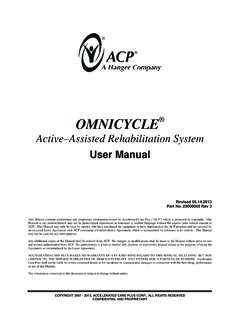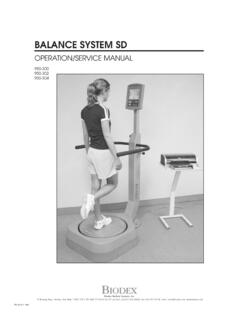Transcription of Muscle Tension Dysphonia Vocal nodules and polyps
1 9/15/2014 1 Hey! It works! Evidence-based approaches to voice therapy Shelley Von Berg, , Associate Professor, CSU, Chico, Department of Communication Sciences and Disorders ArkSHA State Convention, October 2014 Workshop goals Discuss assessment and treatment of those voice disorders that are hyperfunctional in origin; Describe the diagnostic probe and explain its importance in voice therapy; Explain procedural aspects of selected probes; Generate child voice goals that are easy to operationally define and to measure. Muscle Tension Dysphonia The most prevalent voice disorder in both children and adults. A consequence of Vocal hypertension and/or hyperfunction. Considered functional. These functional behaviors over time lead to organic changes, such as swelling, nodules and polyps . Vocal nodules and polyps Nature & Etiology Benign lesions usually occurring at the anterior-middle third aspect of the Vocal fold nodules are generally bilateral and occur due to repeated and chronic Vocal abuse polyps are generally unilateral and are often precipitated by a single Vocal event Both types of lesions are resolved with behavioral voice therapy (Holmberg, 2001; Yamaguchi, 1986; McFarlane & Watterson, 1990) Vocal nodules and polyps Vocal nodules and polyps Vocal quality Often characterized by severe Dysphonia Diplophonia Air escape and short utterances Low pitch and rough, breathy and hoarse Vocal quality Client often coughs and clears throat and complains of globus (sensation of fullness at the laryngeal level) 9/15/2014 2 Patient: 42 year old school teacher and recreational singer.
2 Complaints: Upper respiratory infection and sequela of two months duration, accompanied by excessive coughing, throat clearing. Patient reports heavy Vocal use and Vocal fatigue (MTD). Assessment: Perceptually, patient presents with low speaking frequency and occasions of fry at the ends of phrases. Endoscopy revealed puffy Vocal folds bilaterally with thick mucus throughout the supraglottis. Polyp was observed at the medial margin of the right Vocal fold with the right ventricular fold impinging slightly on the TVF. Vocal nodules and polyps Interview patient regarding Vocal demands and Vocal overuse. If possible, employ ambulatory monitoring. Redirection Tone focus Pitch shift up using nasal glides Silent cough Vocal nodules and polyps Intervention Yawn-sigh followed by breathy voice. Breathy voice with open mouth approach. Pitch shift up Silent yawn-sigh Boom Vocal nodules and polyps Intervention Vocal Abuse and Misuse Reductions Replace coughing and throat clearing with sniff swallow and silent cough.
3 Use voice amplification.* Speak and sing within the appropriate pitch range and loudness. Reduce/eliminate smoking, caffeine and alcohol use. Monitor exercise behaviors. 1 Child Voice Evaluation & Intervention Shelley Von Berg, , Associate Professor, CSU, Chico, Department of Communication Sciences and Disorders ArkSHA State Convention October 2014 Initial Interview with Child and Family Explore organic factors that may underlie behavioral abuse and overuse (URIs, asthma, reduced hearing acuity). Familial influences School activities (large classrooms, playground, choir) Extracurricular Sports Martial arts Descriptive Terminology Clapping hands Balloons Airflow through palms with and without marble Audio and videotape child interacting with parents, siblings and peers. Review videotapes of normal and pathologic Vocal folds. Vocal Hygiene Identify times of Vocal abuse. Explore alternative methods (gestures, whistling).
4 Increase water intake. Replace coughing and throat clearing with sniff-swallow and silent cough. Designate Quiet Times at home. Just Right Voice Incorporate Just Right Voice theme throughout therapy, school and home. Child identifies Just Right Voice qualities. Just Right Voice goals book is issued to the child. Child, siblings, parents and educators establish goals. May develop thematic books that child can read and color; later these books may be incorporated into a play. Pair Clients Visi-Pitch analysis Audiotape or videotape is a suitable alternative Facilitation techniques: Yawn sigh Easy onset Glottal fry Breathy voice Inhale rose Confidential tone Focus Blending Tongue protrusion /i/ Spontaneous speech 2 Vocal nodules in a child Community Intervention Day One Client, siblings and clinicians perform play. Discussion period (children identify healthy and abusive Vocal qualities).
5 Children watch videotape of laryngeal function and make models of larynges. Community Intervention Day Two Review play. Screen segments of popular movies and cartoons. Experiment with moist and dry consistencies (noodles, flowers). Create larynges out of construction paper. Teacher may incorporate protocol into lesson plans. Community Intervention Child must be aware of Dysphonia . Motivators must be identified. Child should easily demonstrate voice techniques. Sibling, peer, parental and teacher support. Child should be able to monitor and adjust Vocal behavior internally. The Role of the School-Based SLP Why do many students with voice disorders fail to receive speech services? Because it is thought that their disability does not adversely affect educational performance. Individuals with Disabilities Education Act Has educational performance ever been defined in federal regulations?
6 No. But, the Department of Education and the Office of Special Education Programs, issued a number of policy letters interpreting this phrase. Education performance, under IDEA, Includes effect upon academic and non-academic areas. 3 Furthermore.. If the presence of a speech-language impairment has been established by a SLP through appropriate appraisal procedures, the receipt of services is not conditional upon academic performance. A child who is achieving at grade level can still qualify as having a speech language disability. Andrews (2002, 593) Impact of Voice Disorders on Education Dysphonia may seriously limit classroom participation Social-emotional implications of a voice disorder are many Children with a limited number of Vocal strategies may be evaluated negatively Many occupations demand efficient verbal communication skills. Poor voice is more difficult to change in later life Andrews, 2002 (Appendix E, 586-594) Sample IEP Worksheet Present level of Education performance Communication Based on: Voice screening and survey*and clinical observations.
7 Charlie is a 9-year-old male with grade-appropriate speech and language skills, however, his Vocal quality, pitch and loudness are not within normal limits, as measured by the following: *Boone, DR, 2004; Lee, Stemple, Glaze and Kelchner, 2004 Voice Screen Findings Breath support: Charlie presents with too little breath support for speech. He produces about 3 words per phrase. Average words per phrase is 8. MPT: Charlie s MPT is 6 seconds. The average MPT for same age peers is 16 seconds. Pitch: Charlie presents with a pitch that is below normal limits for same age peers. His speaking frequency is about a G3 (196 Hz), which is about 40-60 Hz below normal. Quality: Charlie presents with a hoarse voice that sometimes turns into a whisper. The GRBAS revealed a score of moderate/severe Dysphonia . Effects of Disability on Participation in General Curriculum When Charlie contributes in class, it is observed that his voice is hoarse at least 50% of the time, and aphonic (no voice) 30% of the time.
8 His teacher states that he speaks in a rough and low voice, and that from the week of 3/14- 3/18, he lost his voice on three occasions. His Vocal nodules have been verified by a medical doctor. Charlie s hoarse voice interferes with his ability to participate in daily educational interactions. Effects of Disability on Participation in General Curriculum Priority educational needs: To improve the quality of Charlie s voice so that he can participate in all educational activities during the day. Measurable Annual Goal: During all oral school activities, Charlie will use Vocal hygiene and voice strategies to produce a clear, age-appropriate voice 4/5 days a week for three school weeks. 4 Short-term Objectives Charlie will identify and modify Vocal abuse and overuse occasions with 90% accuracy by logging these events in his daily JRV book. Charlie will discriminate between JRV samples of himself and two of his peers with 90% accuracy.
9 Charlie will demonstrate and teach Vocal hygiene and voice strategies to family members and friends, as documented in his JRV book. Charlie will engage in JRV when communicating orally in his classes as measured by his instructors, in 8/10 opportunities. Evaluation Plan Charlie s progress toward annual goals will be measured by: Teacher/clinician observations. Voice quality, pitch and loudness data collected on a weekly basis. Review of Charlie s JRV book and related charts on a weekly basis. References Andrews, (2002). Voice Treatment for Children and Adolescents. San Diego: Singular Publishing Group, Inc. Boone, (1993). The Boone Voice Program for Children (2nd ed.), Austin, TX: Pro-Ed. Finnegan, (1984). Maximum phonation time for children with normal voice. Journal of Communication Disorders, 17, 309-317. Goldman-Eisler, F. (1968). Psycholinguistics: Experiments in spontaneous speech.
10 New York: Academic Press. Lee, , Stemple, , Glaze, L. Kelchner, (in press). Quick screen for voice, and supplementary documents for identifying pediatric voice disorders. Language Speech and Hearing Services In the Schools. 9/15/2014 1 Hey, it works! Evidence-based approaches to functional aphonia Shelley Von Berg, Associate Professor and Clinical Instructor Communication Sciences and Disorders CSU, Chico What is Muscle Tension Dysphonia (MTD)? MTD is a persistent Dysphonia associated with excessive laryngeal and related musculoskeletal Tension . Tension may result in hyperfunctional true and/or false Vocal fold vibratory patterns. MTD Patient is an educator who has not been able to work for 4 months secondary to Dysphonia . Fiberoptic evaluation at Stanford revealed Muscle Tension Dysphonia . Client currently prescribed with PPIs and antihistamines. Produces voice when she clears throat and laughs.



